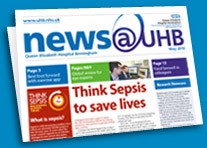Your views

Your feedback is vital to us as we continue to increase the quality of our services.
You are here:
Date: 27 January 2025
Time: 17:11
Volunteers train as guides for blind visitors
Story posted/last updated: 01 August 2013
Volunteers at Queen Elizabeth Hospital Birmingham (QEHB) are finding out what it's like to be visually impaired following the introduction of a new training scheme involving Guide Dogs for the Blind.
The training sessions involve volunteers at the hospital being taught how to assist blind or partially-sighted visitors.
As part of the innovative scheme they have even worn blindfolds to experience for themselves the difficulties associated with having a visual impairment.
The training sessions were held in QEHB’s Education Centre at the end of August, and were attended by 21 volunteers whose role is to welcome visitors to the hospital’s main reception.
Further sessions took place at the end of September and on 8 October, when around 40 more "meet and greet" volunteers were taught sighted guiding techniques. Representatives of Guide Dogs for the Blind were also in the atrium during the week to raise awareness of the charity.
Pat Wilson, University Hospitals Birmingham NHS Foundation Trust's (UHB) Voluntary Services Manager, said: “The volunteers are being trained to be sighted guiders. The aim is to provide help to blind and partially sighted people so, when they arrive at the hospital, they are met by welcomers who are the first to do the training.
“It may seem difficult to approach someone who is blind or partially sighted and we wanted to make sure that everyone knew how to do it properly.”
The training, which is carried out by sighted guide ambassadors from The Guide Dogs for the Blind Association, involves UHB volunteers working together in pairs.
Pat explained: “One person puts on a blindfold and the other guides them around a room without bumping into any of the furniture and then they swap over. The volunteers are then shown how to do it properly.”
After watching a DVD about how to approach and guide a visually impaired person, the trainees then get to expand their guiding skills by going outside the first floor seminar room where the initial training took place.
“The volunteers again take it in turns to guide their blindfolded partner out of the seminar room, down the stairs to the main atrium, then round to the lifts, up to the second floor, and then finally guide them back down the stairs.
“You are trying to guide them rather than force them. You don’t grab their arm, they take your arm so you are steering them and are one step ahead of them, particularly going down stairs.”
Pat, who is now looking to be trained up as one of three UHB sighted guiding practitioners, said everyone had found the sessions beneficial.
“The very next day I saw one of our hospital volunteers actually guiding a blind couple outside to the main car park. One of them had a guide dog with her and her husband used a stick. They were both patients and had been here before but this was the first time that anyone had guided them and they said the whole experience had been much better.”
Once all the front desk volunteers have been trained, it is planned to extend the sessions to other volunteers, such as those based on wards. Reception staff may also be offered guiding training.
Pat added: “The aim is to monitor how many blind and partially sighted people we help, so we are asking volunteers to keep a record. The Guide Dogs for the Blind Association has also asked for feedback as they need to know how much of an impact their training makes.”
Sighted Guide Ambassador Paul Glover, who has helped deliver the training sessions, said: “The aim of Guide Dogs is to ensure that blind and partially sighted people can enjoy the same freedom of movement as everyone else. One way we can achieve this is to make sure that staff and volunteers providing public services are trained to provide safe and confident sighted guide services.
“We are delighted to be working with QEHB to ensure that the volunteers who welcome visitors to the hospital are equipped to give the right kind of help to blind and partially sighted people.”
For more information about sighted guiding, please visit the Guide Dogs website.
University Hospitals Birmingham NHS Foundation Trust is not responsible for the contents or the reliability of external websites and does not necessarily endorse the views expressed within them. Listing should not be taken as endorsement of any kind. We cannot guarantee that links to other websites will work all of the time, and we have no control over the availability of external web pages.

Getting here
Information about travelling to, staying at and getting around the hospital.

Jobs at UHB
A great place to work. Learn why.
news@UHB


RSS feed
Subscribe to our news feed


